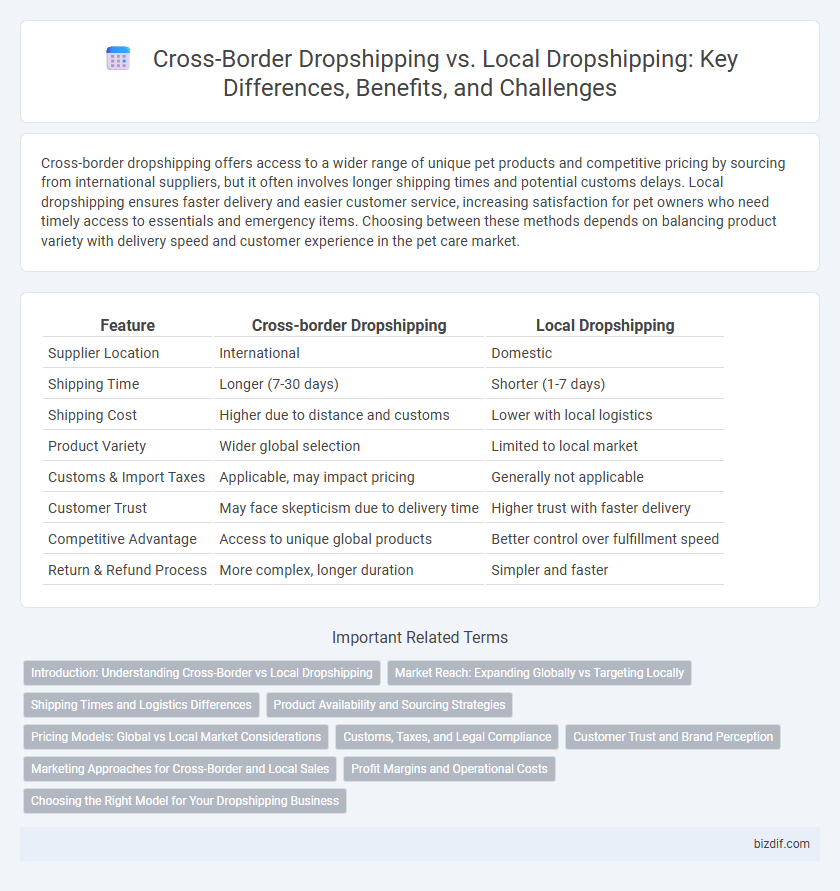Cross-border dropshipping offers access to a wider range of unique pet products and competitive pricing by sourcing from international suppliers, but it often involves longer shipping times and potential customs delays. Local dropshipping ensures faster delivery and easier customer service, increasing satisfaction for pet owners who need timely access to essentials and emergency items. Choosing between these methods depends on balancing product variety with delivery speed and customer experience in the pet care market.
Table of Comparison
| Feature | Cross-border Dropshipping | Local Dropshipping |
|---|---|---|
| Supplier Location | International | Domestic |
| Shipping Time | Longer (7-30 days) | Shorter (1-7 days) |
| Shipping Cost | Higher due to distance and customs | Lower with local logistics |
| Product Variety | Wider global selection | Limited to local market |
| Customs & Import Taxes | Applicable, may impact pricing | Generally not applicable |
| Customer Trust | May face skepticism due to delivery time | Higher trust with faster delivery |
| Competitive Advantage | Access to unique global products | Better control over fulfillment speed |
| Return & Refund Process | More complex, longer duration | Simpler and faster |
Introduction: Understanding Cross-Border vs Local Dropshipping
Cross-border dropshipping involves selling products internationally, leveraging global suppliers and reaching a wider customer base, while local dropshipping focuses on sourcing and delivering products within the same country or region. Cross-border operations can benefit from diverse product options and expanded markets but face challenges like higher shipping costs and longer delivery times. Local dropshipping offers faster fulfillment, reduced shipping expenses, and simplified logistics, making it ideal for businesses targeting specific local markets.
Market Reach: Expanding Globally vs Targeting Locally
Cross-border dropshipping enables businesses to expand their market reach internationally by accessing diverse customer bases across multiple countries, boosting sales potential and brand exposure. Local dropshipping focuses on targeting nearby customers, offering faster shipping times and better control over localized marketing strategies. Choosing between global expansion and localized targeting depends on the seller's capacity to manage logistics, customer service, and market demands effectively.
Shipping Times and Logistics Differences
Cross-border dropshipping typically involves longer shipping times due to international transit, customs clearance, and varied logistics networks, often extending delivery from two to six weeks. Local dropshipping offers significantly faster shipping, often within two to five business days, benefiting from domestic carriers and streamlined logistics processes. The complexity of cross-border regulations and potential delays contrasts with the efficiency and reliability found in local warehousing and fulfillment services.
Product Availability and Sourcing Strategies
Cross-border dropshipping offers access to a wider range of international suppliers, enhancing product availability but often involves longer shipping times and higher logistics complexity. Local dropshipping prioritizes faster delivery and easier return management by sourcing products from domestic suppliers, though it may limit the diversity of available inventory. Effective sourcing strategies in cross-border dropshipping include leveraging global marketplaces and reliable international partnerships, while local dropshipping focuses on building strong relationships with regional wholesalers and manufacturers.
Pricing Models: Global vs Local Market Considerations
Cross-border dropshipping pricing models account for international shipping fees, tariffs, and currency fluctuations, often resulting in higher product costs compared to local dropshipping. Local dropshipping leverages lower shipping expenses and localized pricing strategies, enabling competitive pricing aligned with domestic market demand. Understanding these pricing dynamics is crucial for optimizing profit margins and effectively targeting either global or local customer bases.
Customs, Taxes, and Legal Compliance
Cross-border dropshipping requires thorough understanding of international customs regulations, tax obligations such as VAT or GST, and compliance with import-export laws that vary significantly between countries, increasing operational complexity. Local dropshipping minimizes customs delays and import duties, offering simpler tax reporting and adherence to domestic commerce laws, which reduces legal risks and improves delivery speed. Effective management of customs clearance, tax registration, and conformity with trade regulations is crucial for cross-border dropshipping success, while local dropshipping benefits from streamlined compliance and lower risk of legal penalties.
Customer Trust and Brand Perception
Cross-border dropshipping often faces challenges in customer trust due to longer shipping times and potential customs delays, impacting brand perception negatively. Local dropshipping enhances customer confidence by offering faster delivery and easier returns, fostering a stronger, more reliable brand image. Building transparent communication and clear return policies further strengthens trust irrespective of the dropshipping model.
Marketing Approaches for Cross-Border and Local Sales
Cross-border dropshipping marketing emphasizes global reach through multilingual SEO, international social media campaigns, and localized content tailored to diverse cultural preferences. Local dropshipping marketing leverages geo-targeted ads, community engagement, and local influencer partnerships to build trust and enhance brand loyalty within specific regions. Effective segmentation and customized messaging increase conversion rates by addressing the distinct needs of international versus local customer bases.
Profit Margins and Operational Costs
Cross-border dropshipping typically offers higher profit margins due to access to cheaper suppliers and larger markets, but operational costs such as longer shipping times, customs fees, and potential currency exchange risks can reduce overall profitability. Local dropshipping provides faster delivery and lower shipping costs, leading to improved customer satisfaction and reduced returns, though profit margins may be narrower due to higher local supplier prices. Businesses must balance these factors by evaluating product demand, shipping infrastructure, and customer expectations to optimize profitability.
Choosing the Right Model for Your Dropshipping Business
Cross-border dropshipping expands market reach by sourcing products from international suppliers, offering competitive pricing but involving longer shipping times and potential customs complexities. Local dropshipping provides faster delivery and improved customer service through domestic suppliers, enhancing customer satisfaction and reducing return rates. Selecting the right model depends on your target audience, product niche, and logistics capabilities to balance cost efficiency with customer experience.
Cross-border Dropshipping vs Local Dropshipping Infographic

 bizdif.com
bizdif.com